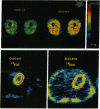Abstract
Physical training increases skeletal muscle insulin sensitivity. Since training also causes functional and structural changes in the myocardium, we compared glucose uptake rates in the heart and skeletal muscles of trained and untrained individuals. Seven male endurance athletes (VO2max 72 +/- 2 ml/kg/min) and seven sedentary subjects matched for characteristics other than VO2max (43 +/- 2 ml/kg/min) were studied. Whole body glucose uptake was determined with a 2-h euglycemic hyperinsulinemic clamp, and regional glucose uptake in femoral and arm muscles, and myocardium using 18F-fluoro-2-deoxy-D-glucose and positron emission tomography. Glucose uptake in the athletes was increased by 68% in whole body (P < 0.0001), by 99% in the femoral muscles (P < 0.01), and by 62% in arm muscles (P = 0.06), but it was decreased by 33% in the heart muscle (P < 0.05) as compared with the sedentary subjects. The total glucose uptake rate in the heart was similar in the athletes and control subjects. Left ventricular mass in the athletes was 79% greater (P < 0.001) and the meridional wall stress smaller (P < 0.001) as estimated by echocardiography. VO2max correlated directly with left ventricular mass (r = 0.87, P < 0.001) and inversely with left ventricular wall stress (r = -0.86, P < 0.001). Myocardial glucose uptake correlated directly with the rate-pressure product (r = 0.75, P < 0.02) and inversely with left ventricular mass (r = -0.60, P < 0.05) or with the whole body glucose disposal (r = -0.68, P < 0.01). Thus, in athletes, (a) insulin-stimulated glucose uptake is enhanced in the whole body and skeletal muscles, (b) whereas myocardial glucose uptake per muscle mass is reduced possibly due to decreased wall stress and energy requirements or the use of alternative fuels, or both.
Full text
PDF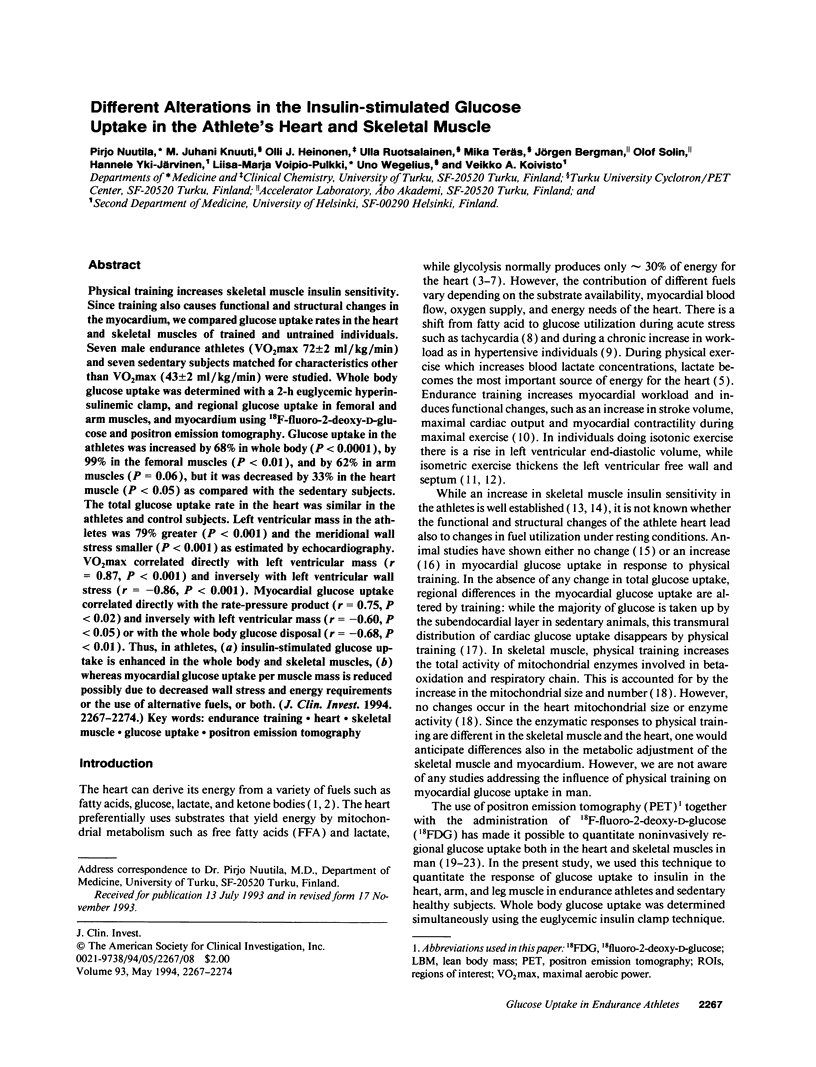
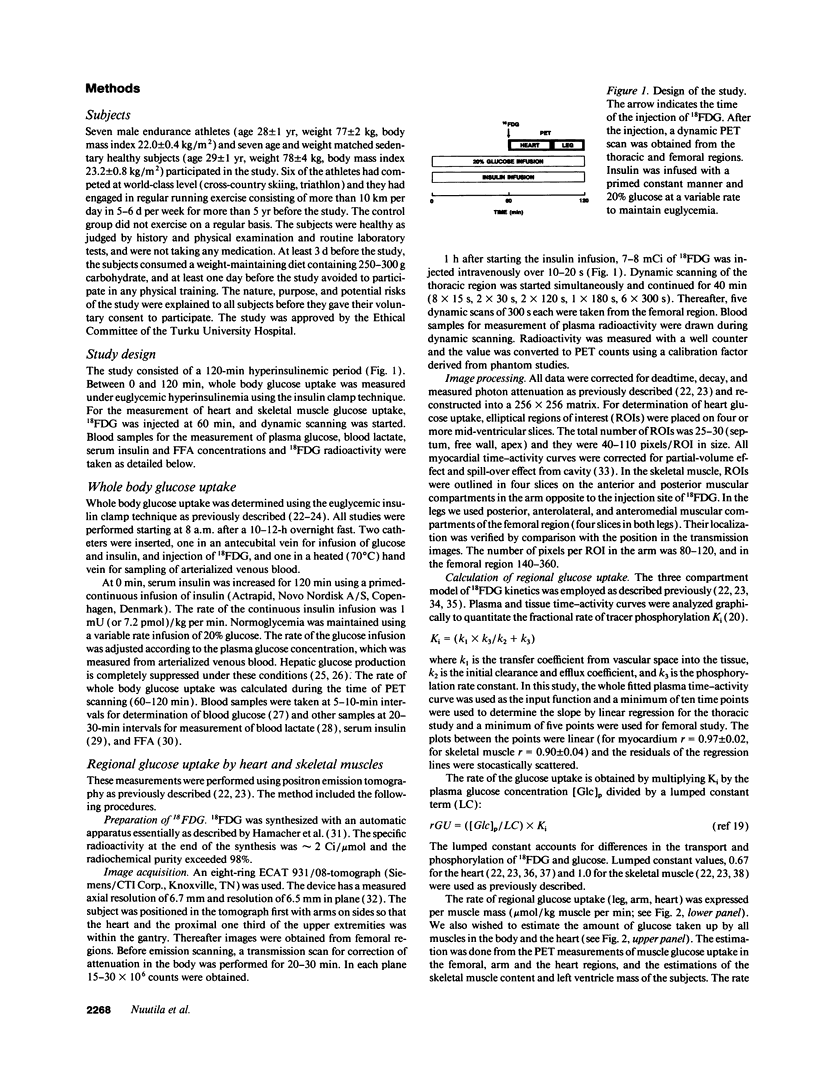
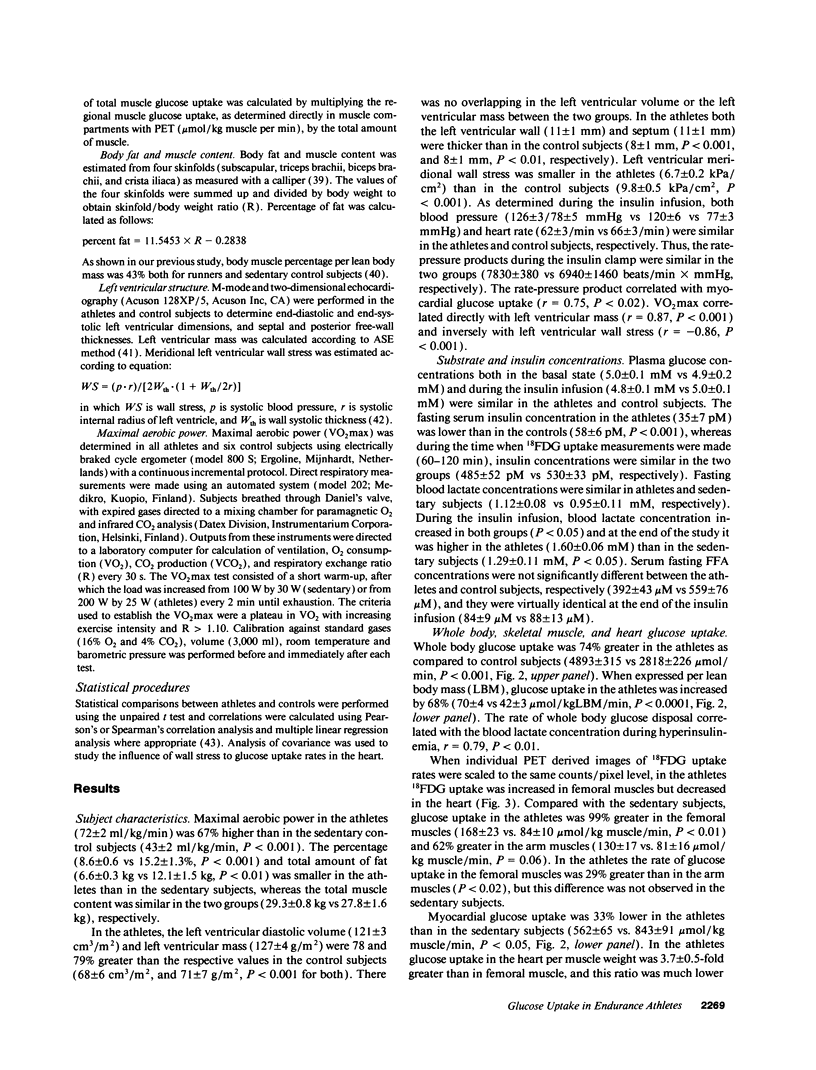
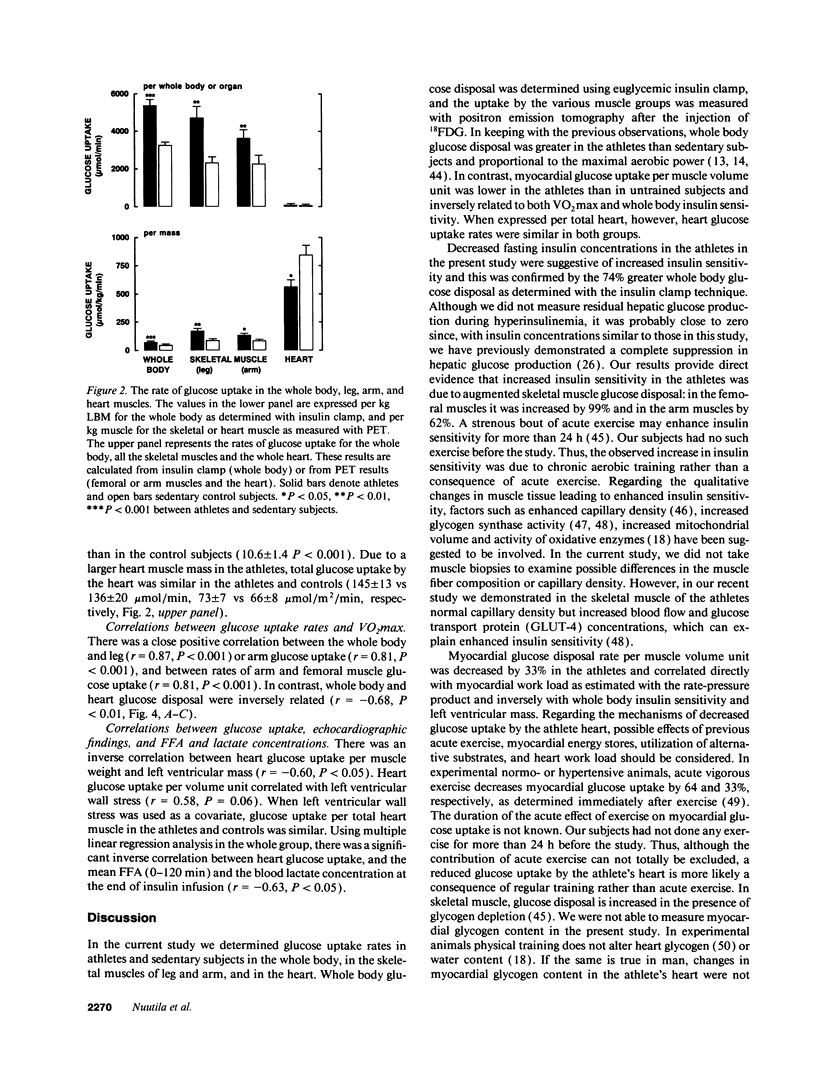
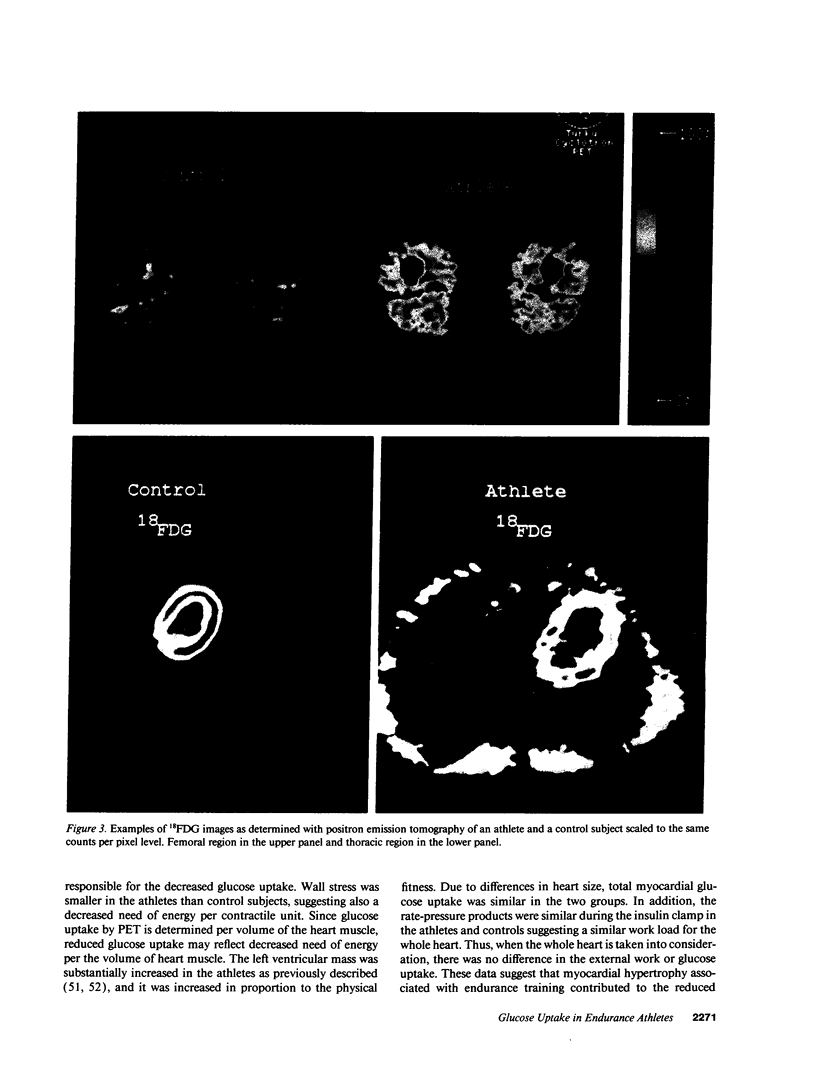
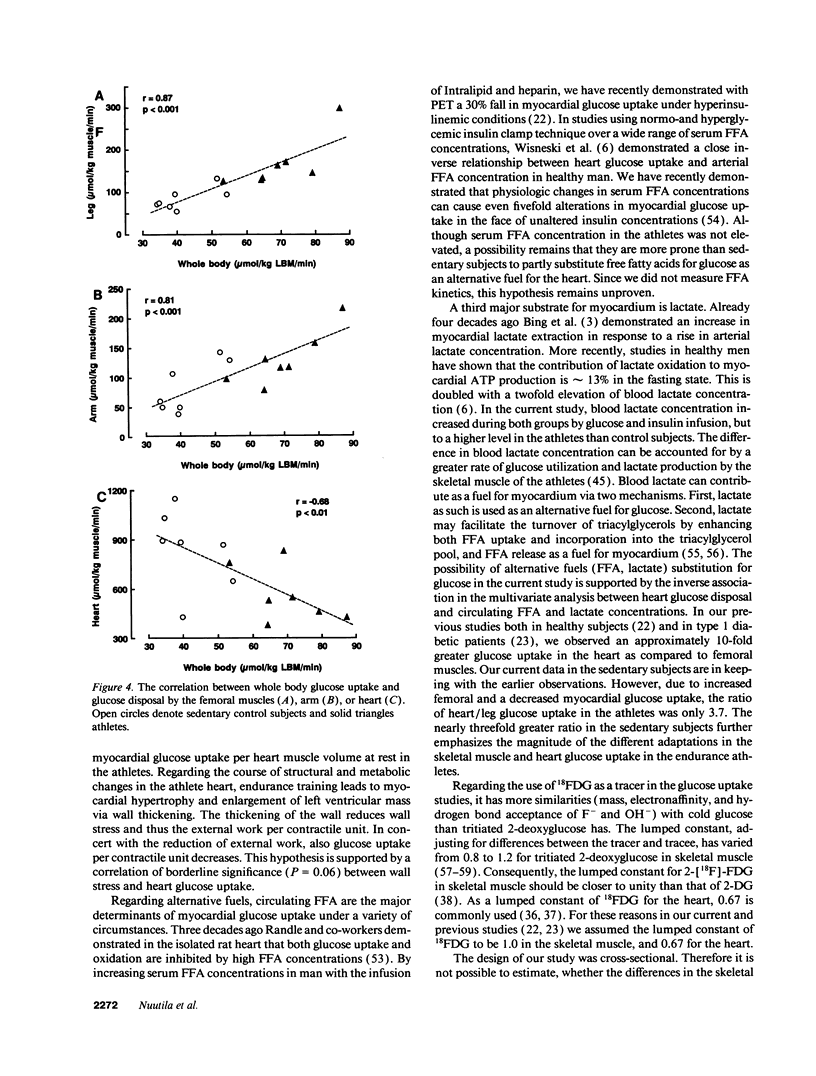
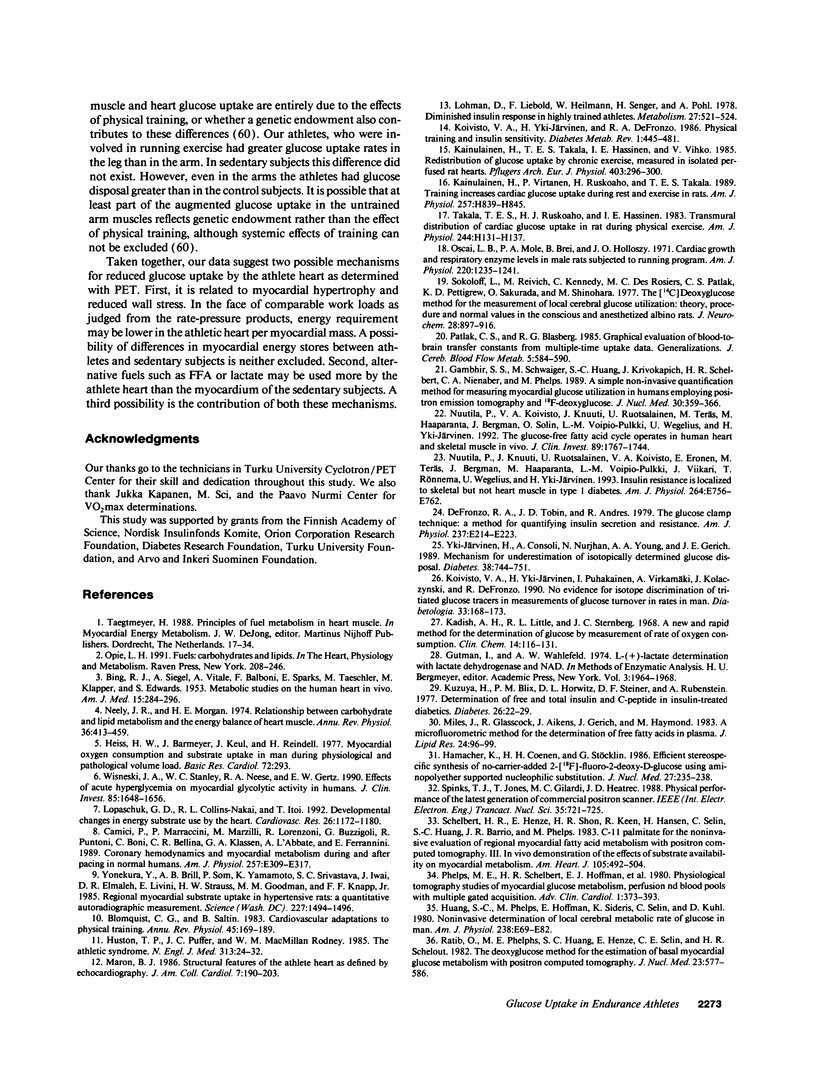
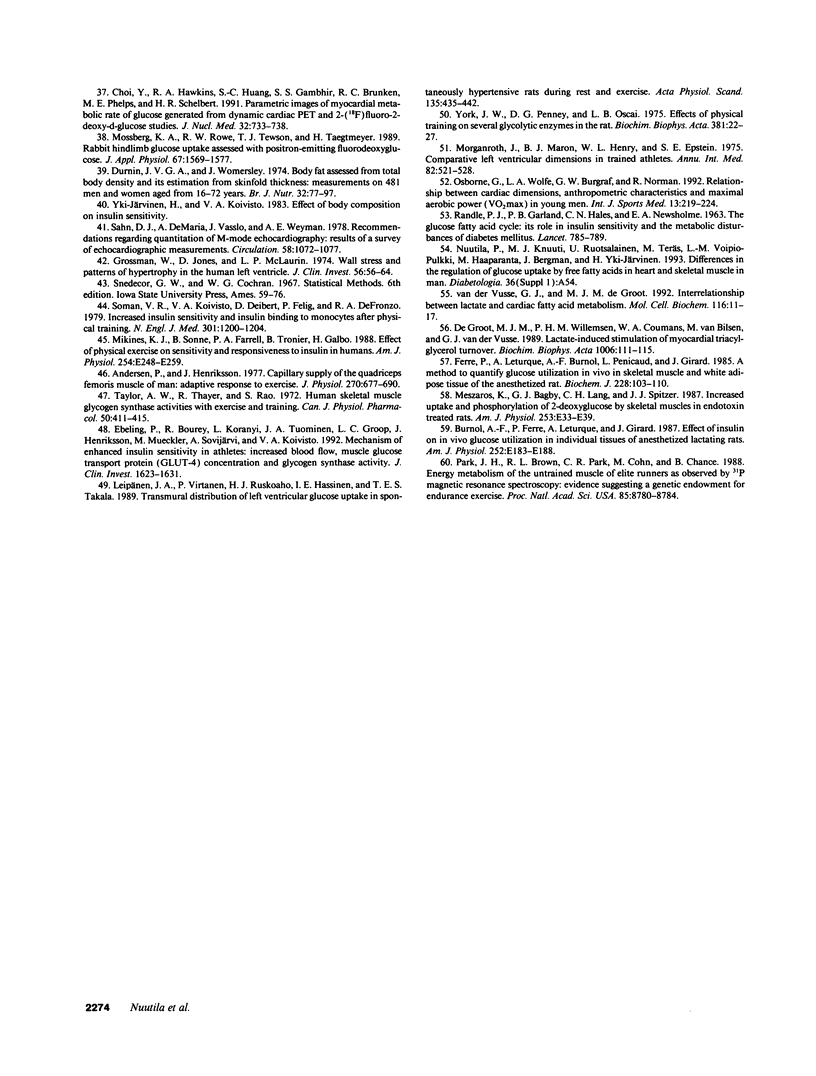
Images in this article
Selected References
These references are in PubMed. This may not be the complete list of references from this article.
- Andersen P., Henriksson J. Capillary supply of the quadriceps femoris muscle of man: adaptive response to exercise. J Physiol. 1977 Sep;270(3):677–690. doi: 10.1113/jphysiol.1977.sp011975. [DOI] [PMC free article] [PubMed] [Google Scholar]
- BING R. J., SIEGEL A., VITALE A., BALBONI F., SPARKS E., TAESCHLER M., KLAPPER M., EDWARDS S. Metabolic studies on the human heart in vivo. I. Studies on carbohydrate metabolism of the human heart. Am J Med. 1953 Sep;15(3):284–296. doi: 10.1016/0002-9343(53)90082-5. [DOI] [PubMed] [Google Scholar]
- Blomqvist C. G., Saltin B. Cardiovascular adaptations to physical training. Annu Rev Physiol. 1983;45:169–189. doi: 10.1146/annurev.ph.45.030183.001125. [DOI] [PubMed] [Google Scholar]
- Burnol A. F., Ferre P., Leturque A., Girard J. Effect of insulin on in vivo glucose utilization in individual tissues of anesthetized lactating rats. Am J Physiol. 1987 Feb;252(2 Pt 1):E183–E188. doi: 10.1152/ajpendo.1987.252.2.E183. [DOI] [PubMed] [Google Scholar]
- Camici P., Marraccini P., Marzilli M., Lorenzoni R., Buzzigoli G., Puntoni R., Boni C., Bellina C. R., Klassen G. A., L'Abbate A. Coronary hemodynamics and myocardial metabolism during and after pacing stress in normal humans. Am J Physiol. 1989 Sep;257(3 Pt 1):E309–E317. doi: 10.1152/ajpendo.1989.257.3.E309. [DOI] [PubMed] [Google Scholar]
- Choi Y., Hawkins R. A., Huang S. C., Gambhir S. S., Brunken R. C., Phelps M. E., Schelbert H. R. Parametric images of myocardial metabolic rate of glucose generated from dynamic cardiac PET and 2-[18F]fluoro-2-deoxy-d-glucose studies. J Nucl Med. 1991 Apr;32(4):733–738. [PubMed] [Google Scholar]
- DeFronzo R. A., Tobin J. D., Andres R. Glucose clamp technique: a method for quantifying insulin secretion and resistance. Am J Physiol. 1979 Sep;237(3):E214–E223. doi: 10.1152/ajpendo.1979.237.3.E214. [DOI] [PubMed] [Google Scholar]
- Durnin J. V., Womersley J. Body fat assessed from total body density and its estimation from skinfold thickness: measurements on 481 men and women aged from 16 to 72 years. Br J Nutr. 1974 Jul;32(1):77–97. doi: 10.1079/bjn19740060. [DOI] [PubMed] [Google Scholar]
- Ferré P., Leturque A., Burnol A. F., Penicaud L., Girard J. A method to quantify glucose utilization in vivo in skeletal muscle and white adipose tissue of the anaesthetized rat. Biochem J. 1985 May 15;228(1):103–110. doi: 10.1042/bj2280103. [DOI] [PMC free article] [PubMed] [Google Scholar]
- Gambhir S. S., Schwaiger M., Huang S. C., Krivokapich J., Schelbert H. R., Nienaber C. A., Phelps M. E. Simple noninvasive quantification method for measuring myocardial glucose utilization in humans employing positron emission tomography and fluorine-18 deoxyglucose. J Nucl Med. 1989 Mar;30(3):359–366. [PubMed] [Google Scholar]
- Grossman W., Jones D., McLaurin L. P. Wall stress and patterns of hypertrophy in the human left ventricle. J Clin Invest. 1975 Jul;56(1):56–64. doi: 10.1172/JCI108079. [DOI] [PMC free article] [PubMed] [Google Scholar]
- Hamacher K., Coenen H. H., Stöcklin G. Efficient stereospecific synthesis of no-carrier-added 2-[18F]-fluoro-2-deoxy-D-glucose using aminopolyether supported nucleophilic substitution. J Nucl Med. 1986 Feb;27(2):235–238. [PubMed] [Google Scholar]
- Heiss H. W., Wink K., Barmeyer J., Keul J., Reindell H. Myocardial oxygen consumption and substrate uptake in man during physiological and pathological volume load. Basic Res Cardiol. 1977 Mar-Jun;72(2-3):293–298. doi: 10.1007/BF01906376. [DOI] [PubMed] [Google Scholar]
- Huang S. C., Phelps M. E., Hoffman E. J., Sideris K., Selin C. J., Kuhl D. E. Noninvasive determination of local cerebral metabolic rate of glucose in man. Am J Physiol. 1980 Jan;238(1):E69–E82. doi: 10.1152/ajpendo.1980.238.1.E69. [DOI] [PubMed] [Google Scholar]
- Huston T. P., Puffer J. C., Rodney W. M. The athletic heart syndrome. N Engl J Med. 1985 Jul 4;313(1):24–32. doi: 10.1056/NEJM198507043130106. [DOI] [PubMed] [Google Scholar]
- Kainulainen H., Takala T. E., Hassinen I. E., Vihko V. Redistribution of glucose uptake by chronic exercise, measured in isolated perfused rat hearts. Pflugers Arch. 1985 Mar;403(3):296–300. doi: 10.1007/BF00583603. [DOI] [PubMed] [Google Scholar]
- Kainulainen H., Virtanen P., Ruskoaho H., Takala T. E. Training increases cardiac glucose uptake during rest and exercise in rats. Am J Physiol. 1989 Sep;257(3 Pt 2):H839–H845. doi: 10.1152/ajpheart.1989.257.3.H839. [DOI] [PubMed] [Google Scholar]
- Koivisto V. A., Yki-Järvinen H., DeFronzo R. A. Physical training and insulin sensitivity. Diabetes Metab Rev. 1986;1(4):445–481. doi: 10.1002/dmr.5610010407. [DOI] [PubMed] [Google Scholar]
- Koivisto V. A., Yki-Järvinen H., Puhakainen I., Virkamäki A., Kolaczynski J., DeFronzo R. No evidence for isotope discrimination of tritiated glucose tracers in measurements of glucose turnover rates in man. Diabetologia. 1990 Mar;33(3):168–173. doi: 10.1007/BF00404045. [DOI] [PubMed] [Google Scholar]
- Kuzuya H., Blix P. M., Horwitz D. L., Steiner D. F., Rubenstein A. H. Determination of free and total insulin and C-peptide in insulin-treated diabetics. Diabetes. 1977 Jan;26(1):22–29. doi: 10.2337/diab.26.1.22. [DOI] [PubMed] [Google Scholar]
- Leipälä J. A., Virtanen P., Ruskoaho H. J., Hassinen I. E., Takala T. E. Transmural distribution of left ventricular glucose uptake in spontaneously hypertensive rats during rest and exercise. Acta Physiol Scand. 1989 Apr;135(4):435–442. doi: 10.1111/j.1748-1716.1989.tb08601.x. [DOI] [PubMed] [Google Scholar]
- Lohmann D., Liebold F., Heilmann W., Senger H., Pohl A. Diminished insulin response in highly trained athletes. Metabolism. 1978 May;27(5):521–524. doi: 10.1016/0026-0495(78)90017-3. [DOI] [PubMed] [Google Scholar]
- Lopaschuk G. D., Collins-Nakai R. L., Itoi T. Developmental changes in energy substrate use by the heart. Cardiovasc Res. 1992 Dec;26(12):1172–1180. doi: 10.1093/cvr/26.12.1172. [DOI] [PubMed] [Google Scholar]
- Maron B. J. Structural features of the athlete heart as defined by echocardiography. J Am Coll Cardiol. 1986 Jan;7(1):190–203. doi: 10.1016/s0735-1097(86)80282-0. [DOI] [PubMed] [Google Scholar]
- Mikines K. J., Sonne B., Farrell P. A., Tronier B., Galbo H. Effect of physical exercise on sensitivity and responsiveness to insulin in humans. Am J Physiol. 1988 Mar;254(3 Pt 1):E248–E259. doi: 10.1152/ajpendo.1988.254.3.E248. [DOI] [PubMed] [Google Scholar]
- Miles J., Glasscock R., Aikens J., Gerich J., Haymond M. A microfluorometric method for the determination of free fatty acids in plasma. J Lipid Res. 1983 Jan;24(1):96–99. [PubMed] [Google Scholar]
- Mossberg K. A., Rowe R. W., Tewson T. J., Taegtmeyer H. Rabbit hindlimb glucose uptake assessed with positron-emitting fluorodeoxyglucose. J Appl Physiol (1985) 1989 Oct;67(4):1569–1577. doi: 10.1152/jappl.1989.67.4.1569. [DOI] [PubMed] [Google Scholar]
- Mészáros K., Bagby G. J., Lang C. H., Spitzer J. J. Increased uptake and phosphorylation of 2-deoxyglucose by skeletal muscles in endotoxin-treated rats. Am J Physiol. 1987 Jul;253(1 Pt 1):E33–E39. doi: 10.1152/ajpendo.1987.253.1.E33. [DOI] [PubMed] [Google Scholar]
- Nuutila P., Knuuti J., Ruotsalainen U., Koivisto V. A., Eronen E., Teräs M., Bergman J., Haaparanta M., Voipio-Pulkki L. M., Viikari J. Insulin resistance is localized to skeletal but not heart muscle in type 1 diabetes. Am J Physiol. 1993 May;264(5 Pt 1):E756–E762. doi: 10.1152/ajpendo.1993.264.5.E756. [DOI] [PubMed] [Google Scholar]
- Nuutila P., Koivisto V. A., Knuuti J., Ruotsalainen U., Teräs M., Haaparanta M., Bergman J., Solin O., Voipio-Pulkki L. M., Wegelius U. Glucose-free fatty acid cycle operates in human heart and skeletal muscle in vivo. J Clin Invest. 1992 Jun;89(6):1767–1774. doi: 10.1172/JCI115780. [DOI] [PMC free article] [PubMed] [Google Scholar]
- Osborne G., Wolfe L. A., Burggraf G. W., Norman R. Relationships between cardiac dimensions, anthropometric characteristics and maximal aerobic power (VO2max) in young men. Int J Sports Med. 1992 Apr;13(3):219–224. doi: 10.1055/s-2007-1021257. [DOI] [PubMed] [Google Scholar]
- Oscai L. B., Molé P. A., Brei B., Holloszy J. O. Cardiac growth and respiratory enzyme levels in male rats subjected to a running program. Am J Physiol. 1971 May;220(5):1238–1241. doi: 10.1152/ajplegacy.1971.220.5.1238. [DOI] [PubMed] [Google Scholar]
- Park J. H., Brown R. L., Park C. R., Cohn M., Chance B. Energy metabolism of the untrained muscle of elite runners as observed by 31P magnetic resonance spectroscopy: evidence suggesting a genetic endowment for endurance exercise. Proc Natl Acad Sci U S A. 1988 Dec;85(23):8780–8784. doi: 10.1073/pnas.85.23.8780. [DOI] [PMC free article] [PubMed] [Google Scholar]
- Patlak C. S., Blasberg R. G. Graphical evaluation of blood-to-brain transfer constants from multiple-time uptake data. Generalizations. J Cereb Blood Flow Metab. 1985 Dec;5(4):584–590. doi: 10.1038/jcbfm.1985.87. [DOI] [PubMed] [Google Scholar]
- RANDLE P. J., GARLAND P. B., HALES C. N., NEWSHOLME E. A. The glucose fatty-acid cycle. Its role in insulin sensitivity and the metabolic disturbances of diabetes mellitus. Lancet. 1963 Apr 13;1(7285):785–789. doi: 10.1016/s0140-6736(63)91500-9. [DOI] [PubMed] [Google Scholar]
- Ratib O., Phelps M. E., Huang S. C., Henze E., Selin C. E., Schelbert H. R. Positron tomography with deoxyglucose for estimating local myocardial glucose metabolism. J Nucl Med. 1982 Jul;23(7):577–586. [PubMed] [Google Scholar]
- Sahn D. J., DeMaria A., Kisslo J., Weyman A. Recommendations regarding quantitation in M-mode echocardiography: results of a survey of echocardiographic measurements. Circulation. 1978 Dec;58(6):1072–1083. doi: 10.1161/01.cir.58.6.1072. [DOI] [PubMed] [Google Scholar]
- Schelbert H. R., Henze E., Schon H. R., Keen R., Hansen H., Selin C., Huang S. C., Barrio J. R., Phelps M. E. C-11 palmitate for the noninvasive evaluation of regional myocardial fatty acid metabolism with positron computed tomography. III. In vivo demonstration of the effects of substrate availability on myocardial metabolism. Am Heart J. 1983 Mar;105(3):492–504. doi: 10.1016/0002-8703(83)90368-x. [DOI] [PubMed] [Google Scholar]
- Sokoloff L., Reivich M., Kennedy C., Des Rosiers M. H., Patlak C. S., Pettigrew K. D., Sakurada O., Shinohara M. The [14C]deoxyglucose method for the measurement of local cerebral glucose utilization: theory, procedure, and normal values in the conscious and anesthetized albino rat. J Neurochem. 1977 May;28(5):897–916. doi: 10.1111/j.1471-4159.1977.tb10649.x. [DOI] [PubMed] [Google Scholar]
- Soman V. R., Koivisto V. A., Deibert D., Felig P., DeFronzo R. A. Increased insulin sensitivity and insulin binding to monocytes after physical training. N Engl J Med. 1979 Nov 29;301(22):1200–1204. doi: 10.1056/NEJM197911293012203. [DOI] [PubMed] [Google Scholar]
- Taylor A. W., Thayer R., Rao S. Human skeletal muscle glycogen synthetase activities with exercise and training. Can J Physiol Pharmacol. 1972 May;50(5):411–415. doi: 10.1139/y72-064. [DOI] [PubMed] [Google Scholar]
- Wisneski J. A., Stanley W. C., Neese R. A., Gertz E. W. Effects of acute hyperglycemia on myocardial glycolytic activity in humans. J Clin Invest. 1990 May;85(5):1648–1656. doi: 10.1172/JCI114616. [DOI] [PMC free article] [PubMed] [Google Scholar]
- Yki-Järvinen H., Consoli A., Nurjhan N., Young A. A., Gerich J. E. Mechanism for underestimation of isotopically determined glucose disposal. Diabetes. 1989 Jun;38(6):744–751. doi: 10.2337/diab.38.6.744. [DOI] [PubMed] [Google Scholar]
- Yonekura Y., Brill A. B., Som P., Yamamoto K., Srivastava S. C., Iwai J., Elmaleh D. R., Livni E., Strauss H. W., Goodman M. M. Regional myocardial substrate uptake in hypertensive rats: a quantitative autoradiographic measurement. Science. 1985 Mar 22;227(4693):1494–1496. doi: 10.1126/science.3975623. [DOI] [PubMed] [Google Scholar]
- York J. W., Penney D. G., Oscai L. B. Effects of physical training on several glycolytic enzymes in rat heart. Biochim Biophys Acta. 1975 Jan 13;381(1):22–27. doi: 10.1016/0304-4165(75)90185-3. [DOI] [PubMed] [Google Scholar]
- de Groot M. J., Willemsen P. H., Coumans W. A., van Bilsen M., van der Vusse G. J. Lactate-induced stimulation of myocardial triacylglycerol turnover. Biochim Biophys Acta. 1989 Nov 6;1006(1):111–115. doi: 10.1016/0005-2760(89)90330-5. [DOI] [PubMed] [Google Scholar]
- van der Vusse G. J., de Groot M. J. Interrelationship between lactate and cardiac fatty acid metabolism. Mol Cell Biochem. 1992 Oct 21;116(1-2):11–17. doi: 10.1007/BF01270563. [DOI] [PubMed] [Google Scholar]



